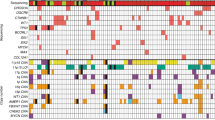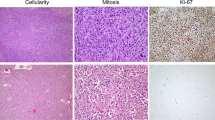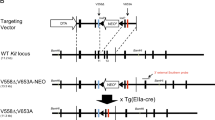Abstract
Downstream signaling that results from the interaction of hepatocyte growth factor/scatter factor (HGF/SF) with the receptor tyrosine kinase Met plays critical roles in tumor development, progression, and metastasis. This ligand–receptor pair is an attractive target for new diagnostic and therapeutic agents, preclinical development of which requires suitable animal models. The growth of heterotopic and orthotopic Met-expressing human tumor xenografts in conventional strains of immunocompromised mice inadequately replicates the paracrine stimulation by human HGF/SF (hHGF/SF) that occurs in humans with cancer. We have therefore generated a mouse strain transgenic for hHGF/SF (designated hHGF-Tg) on a severe combined immunodeficiency (SCID) background. We report here that the presence of ectopically expressed hHGF/SF ligand significantly enhances growth of heterotopic subcutaneous xenografts derived from human Met-expressing cancer cells, including the lines SK-LMS-1 (human leiomyosarcoma), U118 (human glioblastoma), and DU145 (human prostate carcinoma), but not that of M14-Mel xenografts (human melanoma that expresses insignificant levels of Met). Our results indicate that ectopic hHGF/SF can specifically activate Met in human tumor xenografts. This new hHGF-Tg strain of mice should provide a powerful tool for evaluating drugs and diagnostic agents that target the various pathways influenced by Met activity.
This is a preview of subscription content, access via your institution
Access options
Subscribe to this journal
Receive 50 print issues and online access
$259.00 per year
only $5.18 per issue
Buy this article
- Purchase on Springer Link
- Instant access to full article PDF
Prices may be subject to local taxes which are calculated during checkout






Similar content being viewed by others
References
Abounader R, Lal B, Luddy C, Koe G, Davidson B, Rosen EM and Laterra J . (2002). FASEB J., 16, 108–110.
Atabey N, Gao Y, Yao ZJ, Breckenridge D, Soon L, Soriano JV, Burke Jr TR and Bottaro DP . (2001). J. Biol. Chem., 276, 14308–14314.
Ausubel FM, Brent R, Kingston RE, Moore DD, Seidman JG, Smith JA and Struhl K . (1994). Current Protocols in Molecular Biology. Wiley: New York.
Bhargava M, Joseph A, Knesel J, Halaban R, Li Y, Pang S, Goldberg I, Setter E, Donovan MA, Zarnegar R, Michalopoulos GA, Nakamura T, Faletto D and Rosen E . (1992). Cell Growth Differ., 3, 11–20.
Birchmeier C, Birchmeier W, Gherardi E and Vande Woude GF . (2003). Nat. Rev. Mol. Cell. Biol., 4, 915–925.
Bock TA, Orlic D, Dunbar CE, Broxmeyer HE and Bodine DM . (1995). J. Exp. Med., 182, 2037–2043.
Cao B, Su Y, Oskarsson M, Zhao P, Kort EJ, Fisher RJ, Wang LM and Vande Woude GF . (2001). Proc. Natl. Acad. Sci., 98, 7443–7448.
Christensen JG, Schreck R, Burrows J, Kuruganti P, Chan E, Le P, Chen J, Wang X, Ruslim L, Blake R, Lipson KE, Ramphal J, Do S, Cui JJ, Cherrington JM and Mendel DB . (2003). Cancer Res., 63, 7345–7355.
Date K, Matsumoto K, Kuba K, Shimura H, Tanaka M and Nakamura T . (1998). Oncogene, 17, 3045–3054.
Gmyrek GA, Walburg M, Webb CP, Yu HM, You X, Vaughan ED, Vande Woude GF and Knudsen BS . (2001). Am. J. Pathol., 159, 579–590.
Jeffers M, Fiscella M, Webb CP, Anver M, Koochekpour S and Vande Woude GF . (1998). Proc. Natl. Acad. Sci., 95, 14417–14422.
Jeffers M, Rong S and Vande Woude GF . (1996). Mol. Cell. Biol., 16, 1115–1125.
Kerbel RS . (2003). Cancer Biol. Ther., 4 (Suppl. 1), S134–S139.
Koochekpour S, Jeffers M, Rulong S, Taylor G, Klineberg E, Hudson EA, Resau JH and Vande Woude GF . (1997). Cancer Res., 57, 5391–5398.
Mueller BM and Reisfeld RA . (1991). Cancer Metastasis Rev., 3, 193–200.
Qian CN, Takahashi M, Kahnoski RJ and Teh BT . (2003). J. Urol., 170, 994–997.
Rong S, Bodescot M, Blair D, Dunn J, Nakamura T, Mizuno K, Park M, Chan A, Aaronson S and Vande Woude GF . (1992). Mol. Cell. Biol., 12, 5152–5158.
Sakata H, Takayama H, Sharp R, Rubin JS, Merlino G and LaRochelle WJ . (1996). Cell Growth Differ., 7, 1513–1523.
Trusolino L and Comoglio PM . (2002). Nat. Rev. Cancer, 4, 289–300.
Webb CP, Hose CD, Koochekpour S, Jeffers M, Oskarsson M, Sausville E, Monks A and Vande Woude GF . (2000). Cancer Res., 60, 342–349.
Zhang YW, Su Y, Volpert OV and Vande Woude GF . (2003). Proc. Natl. Acad. Sci., 100, 12718–12723.
Acknowledgements
We thank Bryn Eagleson and the Van Andel Research Institute vivarium staff for their expert care of transgenic and nontransgenic mice, and Michelle Reed for the manuscript preparation. This work is supported in part by funding from the Michigan Life Sciences Corridor (MLSC) and by the generosity of the Jay and Betty Van Andel Foundation.
Author information
Authors and Affiliations
Corresponding author
Rights and permissions
About this article
Cite this article
Zhang, YW., Su, Y., Lanning, N. et al. Enhanced growth of human met-expressing xenografts in a new strain of immunocompromised mice transgenic for human hepatocyte growth factor/scatter factor. Oncogene 24, 101–106 (2005). https://doi.org/10.1038/sj.onc.1208181
Received:
Accepted:
Published:
Issue Date:
DOI: https://doi.org/10.1038/sj.onc.1208181
Keywords
This article is cited by
-
Possible role of combined therapy targeting MET and pro-HGF activation for renal cell carcinoma: analysis by human HGF-producing SCID mice
Human Cell (2023)
-
Cancer stem cells are underestimated by standard experimental methods in clear cell renal cell carcinoma
Scientific Reports (2016)
-
Identification of a novel MET mutation in high-grade glioma resulting in an auto-active intracellular protein
Acta Neuropathologica (2015)
-
Bispecific antibodies with natural architecture produced by co-culture of bacteria expressing two distinct half-antibodies
Nature Biotechnology (2013)
-
The decreased metastatic potential of rhabdomyosarcoma cells obtained through MET receptor downregulation and the induction of differentiation
Cell Death & Disease (2013)



